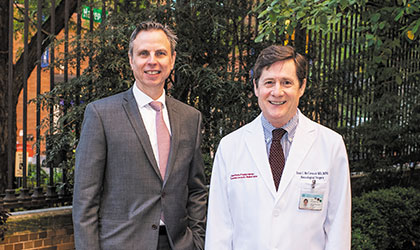Och Spine Care: A Playbook for an Integrated Approach

Dr. Dr. Evan Johnson and Dr. Paul C. McCormick
“Spinal conditions are extraordinarily heterogeneous in terms of causes, effect, natural history, and response to treatments,” says Paul C. McCormick, MD, MPH, Herbert and Linda Gallen Professor of Neurological Surgery, Columbia University Vagelos College of Physicians and Surgeons. “We offer the spine patient the collaboration of the best specialists in the world to identify, evaluate, and then define the most appropriate treatment. It’s like being on a football team: You’d like to be a Super Bowl champion, but you can’t do that by yourself. Each player has certain capabilities.”
The analogy is particularly apt for Dr. McCormick, who as an undergraduate captained the Columbia football team. “Playing on Coach Campbell’s team meant that you were going to wear the Columbia uniform, you were going to be part of something greater than yourself, greater than any individual accomplishment,” says Dr. McCormick. “Likewise, our program brings together individuals with different skill sets and perspectives — inside and outside the OR — working together to optimize the patient’s care.”
Dr. McCormick, and his neurosurgical colleagues, Peter D. Angevine, MD, and Christopher E. Mandigo, MD, work closely with the spine surgeons in Columbia’s Department of Orthopedic Surgery. Most recently, two new spine surgeons, Patrick C. Reid, MD, and Simon Morr, MD, with joint appointments in neurosurgery and orthopedic surgery have come on board. The neurosurgeons and orthopedic surgeons operate in the NewYork-Presbyterian Och Spine Hospital, which will soon have six dedicated ORs designed explicitly for spinal procedures. In August 2018, an integrated neuro surgery and orthopedic spine fellowship program was established with rotations through both specialties.
Evan Johnson, DPT, Assistant Professor, Columbia University Vagelos College of Physicians and Surgeons, serves as administrator for the spine program and oversees physical therapy and research for the NewYork-Presbyterian Och Spine Hospital. “Because there are so many specialties involved in spine disorders, the most important communication is not between specialists in the same discipline, but with all the other practitioners involved in the patient’s care,” says Dr. Johnson. “So how do you put systems in place that facilitate the care process? That was our thinking as we developed our program.”
The spine care team has developed standardized safety practices, including preoperative protocols to lower risk for complications and postoperative guidelines for mobilization and medication.
Importantly, the NewYork-Presbyterian Och Spine Hospital provides the infrastructure to facilitate integrated spine care — one location where all disciplines practice and interact, uniting the expertise of neurosurgeons, neurologists, orthopedic surgeons, physia trists, pain management specialists, physical therapists, and specialized nursing staff. “We have implemented very clear-cut strategies to enhance this integration,” notes Dr. McCormick. “We have case conferences every week as well as indication conferences where upcoming operations are shared. And we have quality assurance rounds. When we have a suboptimal outcome, we analyze it, learn from it, and improve care overall.”
“In addition, it’s very important to distinguish care of the individual who has an acute or subacute condition from the individual who has a chronic disease process,” adds Dr. Johnson. “We knew that we had to differentiate the pathway of each patient group for maximum efficiency.” The solution: A call center that operates across multiple departments and a registered nurse navigator who triages patients and schedules appointments.



